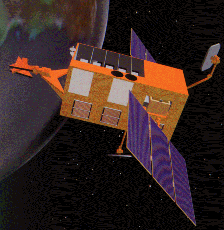Covering Space From Earth to the Edge of the Universe
| Cover | Global Links | Solar System | Deep Space | Rockets |
| Satellites | Space Shuttles | Space Stations | Astronauts & Cosmonauts |
Burps Asteroid-Sized Chunk
 Astronomers observing a disk of matter surrounding a black hole in our Milky Way galaxy have discovered the disk periodically hurls out jets of matter at nearly the speed of light in opposite directions. The black hole replenishes its disk of matter by pulling hot gas off the surface of a nearby companion star. Each time, it undergoes another disruption, repeating the burp-like sequence at half-hour intervals.
Astronomers observing a disk of matter surrounding a black hole in our Milky Way galaxy have discovered the disk periodically hurls out jets of matter at nearly the speed of light in opposite directions. The black hole replenishes its disk of matter by pulling hot gas off the surface of a nearby companion star. Each time, it undergoes another disruption, repeating the burp-like sequence at half-hour intervals. Research teams at California Institute of Technology at Pasadena, Massachusetts Institute of Technology (MIT) at Boston, and NASA's Goddard Space Flight Center at Greenbelt, Maryland, in 1997 correlated the disappearance of X-ray emitting hot gas in the disk with the appearance, shortly thereafter, of rapidly expanding jets.
X-ray images showing the disappearing disk were obtained by NASA's Rossi X-ray Timing Explorer (RXTE) satellite, depicted above left by a NASA artist. Infrared observations demonstrated that, when the X-rays from the disk vanish, the jets suddenly appear.
Such disks of hot gas, known as accretion disks, often are observed around black holes with orbiting stellar companions. However, the almost simultaneous disappearance of the disk and formation of the jet has never been seen before. The discovery sheds light on the origin of the enigmatic jets, also commonly observed near accreting black holes, but poorly understood.
The system behaves like the celestial version of the "Old Faithful" geyser found on Earth. At fairly regular intervals, the accretion disk is disrupted and a fast moving jet is produced. This jet is staggeringly more powerful than the "Old Faithful" geyser, of course. Every half-hour, the black hole, in the constellation Aquila, throws off a mass equal to a 100 trillion ton asteroid at nearly the speed of light (approximately 650 million miles per hour). This process requires a lot of energy. For instance, each cycle is equivalent to six trillion times the annual energy consumption of the entire United States.
What is a black hole?
Black holes are very massive objects with gravitational fields so intense that nothing near them can escape their pull, not even light. While this prevents anyone from observing black holes directly, their presence can be inferred from effects on nearby matter. Many of the known or suspected black holes have companion stars orbiting nearby. A black hole's gravity pulls gas from the companion star into a swirling disk of material which orbits around the black hole, much as soap suds swirl around a bathtub drain. As the gaseous matter in the disk falls into the black hole, the gas in the disk is compressed and heated to millions of degrees. That causes it to emit X-rays.
X-rays from "Old Faithful"
Scientists found that the X-rays from the "Old Faithful" disk disappeared almost completely every half hour. About five minutes later, they would return again. The results of the RXTE satellite's X-ray observations, infrared observations at Mt. Palomar, California, and infrared and radio observations made by the Centre d'Etudes de Saclay, France, using the United Kingdom Infrared Telescope and the Very Large Array in New Mexico, showed that very shortly after the X-rays vanished, jets appeared at infrared and radio wavelengths.
Since X-ray emitting hot gas in the disk disappears during these episodes, the research team concluded that the matter in the disk must have escaped, probably flung out in the jets. As the black hole pulls more gas from its companion star, the disk appears again, along with the X-rays, and the cycle starts over.
- Read more about NASA's Rossi X-ray Timing Explorer (RXTE)
- NASA's Rossi X-ray Timing Explorer RXTE images
- NASA's Rossi X-ray Timing Explorer RXTE videos
| Top of this page | More stories | Deep space main page | Space Today Online cover |